Gelber Stern is a historic street in Hildesheim, a city in Lower Saxony in Germany.
Contents



Gelber Stern is a historic street in Hildesheim, a city in Lower Saxony in Germany.



Gelber Stern is a street with 135 m in length in the Southern part of the city center. [1] Lappenberg, the middle of the former Jewish community, is close by.
In a document dating from 1650 the street was mentioned for the first time. [2] Its name was then "Geiler Stert", but the meaning of this name remains unknown. The present name "Gelber Stern" has been used since the beginning of the 19th century. Literally translated it means "Yellow Star", but most probably this name does not refer to the Star of David as the street was not a part of the Jewish community.
In the Second World War, Gelber Stern and the streets and lanes around received comparatively little damage. Some houses were lightly damaged during air raids on 22 February 1945 and on 22 March 1945, but the damage could be repaired preserving the original style after the war.
Gelber Stern is one of the most picturesque streets of Hildesheim as most of the buildings are half-timbered houses. Many of them were built on a sandstone base and in some houses the upper floor is larger than the ground floor. One of the most interesting is no. 21, called Waffenschmiedehaus (Armourer's House) dating from 1548 with colourful wood carvings in a renaissance style. [3] Carved inscriptions can be seen in the façades of several houses, e.g. no. 14 - 16 which were built at the end of the 16th century. A complete prayer consisting of four sentences was carved into the façade of house no. 17.
The large building on the corner of Gelber Stern and Brühl is a former hospital which was built in a classicist style 1833–1840. Today it is used as a priests' seminary. The oldest half-timbered house of Hildesheim, which is used as a library today, can be visited in its inner court. It was built in a gothic style at the end of the 15th century. [4]

Hildesheim[ˈhɪldəsˌhaɪ̯m](listen) is a city in Lower Saxony, Germany with 101,693 inhabitants. It is in the district of Hildesheim, about 30 km (19 mi) southeast of Hanover on the banks of the Innerste River, a small tributary of the Leine River.

Marienrode Priory is a Benedictine nunnery in Marienrode, a district of Hildesheim in Germany.
Abraham Lewinsky was a late nineteenth to early twentieth century German rabbi. He was born on March 1, 1866, in Loslau, Upper Silesia, Kingdom of Prussia. He studied at the University of Breslau from 1884 to 1887, obtaining a (Ph.D.), while pursuing his rabbinical studies at the Jewish Theological Seminary in Breslau. In 1890 he became rabbi to Weilburg, and two years later assumed leadership as land rabbi of the Land Rabbinate of Hildesheim in the Province of Hanover, retiring in 1935. He died December 18, 1941, in Mainz, People's State of Hesse.
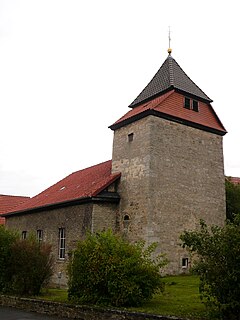
St. Martin's is a Lutheran church in Groß Ellershausen, Göttingen, Lower Saxony, Germany. It is significant as possibly retaining the oldest existing structure, its tower, in southern Lower Saxony. While the details of the origin of the church building have been lost in the mist of history, architectural analysis indicates that the Romanesque church tower was most likely built in the tenth or eleventh century. The remains of a hearth on the second floor have led to the conclusion that the tower was originally a Wohnturm of a titled family, probably the Herren von Ellershausen, which lived there at the time. The church's ship is much younger, probably having been built or re-built during the Barocque era. It was repaired in 1838..
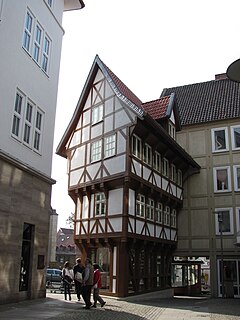
The Upended Sugarloaf is a half-timbered house in the city of Hildesheim in the federal state of Lower Saxony in Germany.
Lappenberg is a historic street in Hildesheim, a city in Lower Saxony in Germany. It was the center of the Jewish community.

The Historic Market Place is a historical structure in the city of Hildesheim in Lower Saxony, Germany
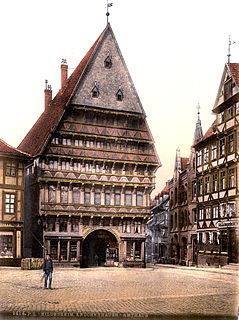
The Butchers' Guild Hall is a half-timbered house in Hildesheim in the federal state of Lower Saxony, Germany.

Marienburg Castle is a well-preserved Romanesque castle in Hildesheim, a city in Lower Saxony, Germany.
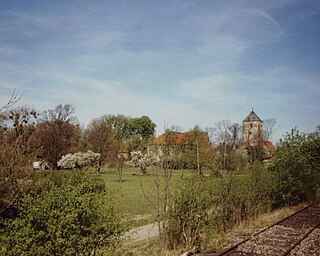
Steuerwald Castle is a Romanesque castle in Hildesheim, a city in Lower Saxony, Germany.
St. Bernward's Church is a Catholic church in the city of Hildesheim in Lower Saxony, Germany. The name refers to the bishop Bernward of Hildesheim (960-1022) who was canonized by Pope Celestine III.
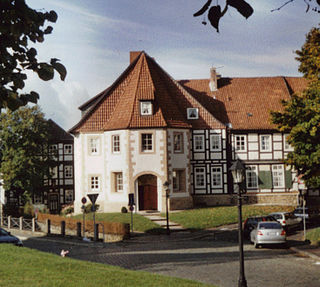
St. Nicholas' Chapel is a former Roman Catholic parish church in the city of Hildesheim in Lower Saxony, Germany. It is dedicated to Saint Nicholas and is located in the southern part of the old city centre, opposite St. Godehard.
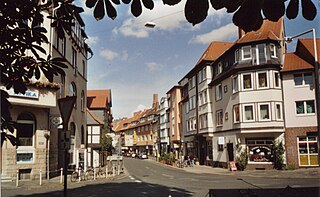
Moritzberg is a quarter in the city of Hildesheim in Lower Saxony, Germany. It is on a hill in the west of the city, about a mile from the Cathedral. It was an independent market town until 1911.

The Hospital of the Five Wounds is a half-timbered house in the city of Hildesheim in Lower Saxony, Germany. It is in the southern part of the old city center, opposite St. Godehard and behind St. Nicolai's Chapel.

Erbsen is a village in the Flecken Adelebsen in the Landkreis Göttingen in Lower Saxony, Germany. The village has about four hundred inhabitants. It lies some twelve kilometers west of Göttingen on the main road to Adelebsen proper.

Magdalenengarten is a baroque park in Hildesheim in Lower Saxony, Germany.

The Bernward Doors are the two leaves of a pair of Ottonian or Romanesque bronze doors, made c. 1015 for Hildesheim Cathedral in Germany. They were commissioned by Bishop Bernward of Hildesheim (938–1022). The doors show relief images from the Bible, scenes from the Book of Genesis on the left door and from the life of Jesus on the right door. They are considered a masterpiece of Ottonian art, and feature the oldest known monumental image cycle in German sculpture, and also the oldest cycle of images cast in metal in Germany.

Pomorska Street is an important street in downtown Bydgoszcz.

The Villa Nordstern is a former grand residence on the Iltener Straße in Lehrte, Lower Saxony, Germany. It was built for industrial magnate Hermann Manske in 1892. Since 1990 it has stood abandoned, although there have been a variety efforts to restore it as a historic monument or private development.

Heinrich August Anton Gerber was a German architect.